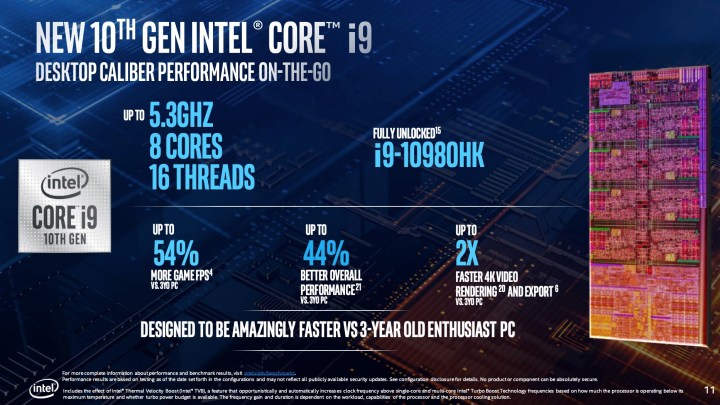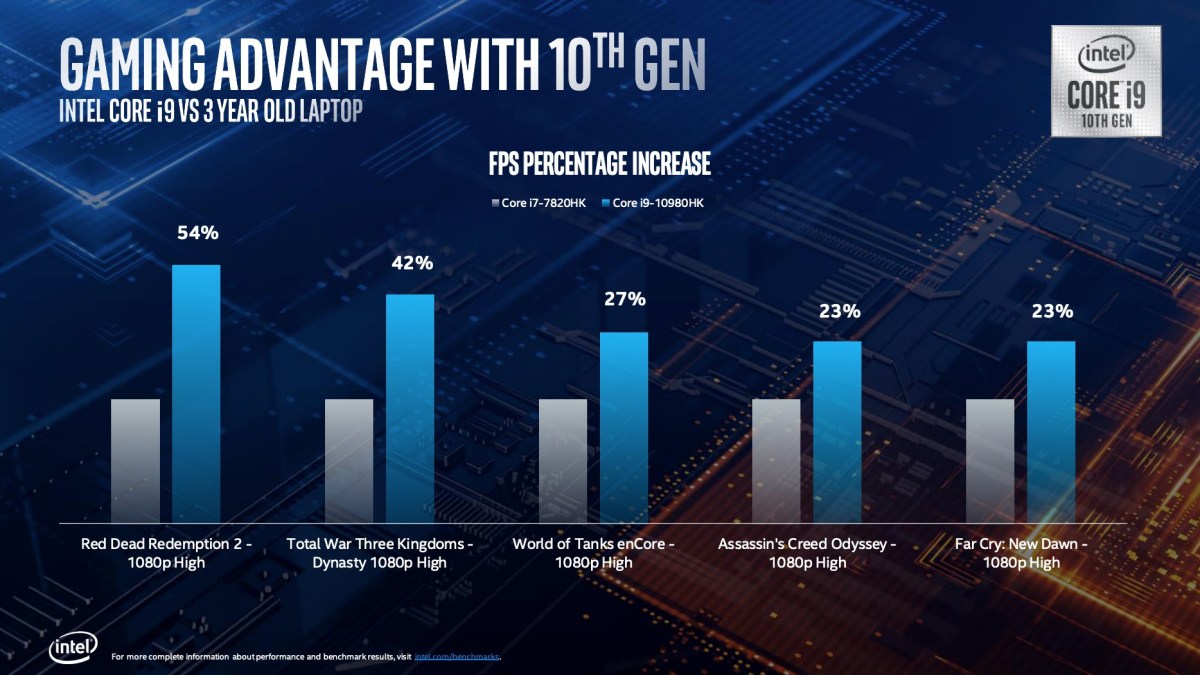Intel has launched a new series of laptop processors, the 10th-gen Comet Lake-H chips. These are 45-watt CPUs meant for gaming laptops and powerful content creation machines.
This comes hot on the heels of an aggressive attack from its rival, AMD. The company’s new Ryzen 4000 laptop processors bring eight-core, sixteen-thread power to
The headlining features are a new eight-core Core i7 and a monster Core i9 with turbo speeds of up to 5.3GHz. Is this enough to take back the momentum from AMD?
Comet Lake-H Specs

Intel’s H-series processors are some of the most important chips in their lineup. Whether it’s a gaming laptop like a Razer Blade or a content creation device like the Dell XPS 15, it likely has one of these chips at its heart.
Intel expects over 100 designs to use Comet Lake-H chips this year, which includes over 30
Here’s how the lineup of H-series chips looks this year:
| Cores/Threads | Base clock | Turbo frequencies
(single-core) |
Cache | TDP | |
| Intel Core i9-10980HK | 8/16 | 2.4GHz | 5.3GHz | 16MB | 45w |
| Intel Core i7-10875H | 8/16 | 2.3GHz | 5.1GHz | 16MB | 45w |
| Intel Core i7-10850H | 6/12 | 2.7GHz | 5.1GHz | 12MB | 45w |
| Intel Core i7-10750H | 6/12 | 2.6GHz | 5.0GHz | 12MB | 45w |
| Intel Core i5-10400H | 4/8 | 2.6GHz | 4.6GHz | 8MB | 45w |
| Intel Core i5-10300H | 4/8 | 2.6GHz | 4.5GHz | 8MB | 45w |
The first eight-core Core i9 was released in 2019, and an eight-core Core i9 is once again at the top of the stack. Its headline feature is the 5.3GHz turbo frequency. This is a big jump over last year’s Core i9, which topped out at 4.9GHz. In terms of clock speed, it’s even faster than the latest 9900K and 9900KS desktop parts.
Intel is using its TVB (Thermal Velocity Boost) 3.0 for short bursts of clocked-up frequencies. These speeds aren’t meant to be sustained, but are made for quick, bursty workloads like photo editing, or loading certain games. With TVB 2.0, the feature was reserved for the Core i9 parts, but this year, it has been extended to the Core i7 chips as well.
What about all-core turbo? Intel has downplayed its sustained all-core clock speeds in recent generations, and that hasn’t changed in Comet Lake-H. An Intel representative did mention the Core i9 chip can boost to 4.4GHz with all cores activated.

The previous mobile Core i9 was a popular choice in
It should be noted that while Intel is stressing its high single-core boost speeds, the Ryzen chips offer higher base clocks. The Ryzen 9 4900H sits at 3.3GHz and the Ryzen 7 4900H at 2.9GHz.
Further down the stack, Intel’s lineup is familiar, with two six-core Core i7s and two four-core Core i5s. These processors get the same 8% uptick in boost clocks, and a minor bump in base clock. AMD’s respective Ryzen 5 chip has two more cores, four more threads, and a higher 3.0GHz base clock speed.
Performance
Intel’s briefing didn’t focus much on comparisons against AMD, or even Intel’s own 9th-gen chips. Rather, the company focused on the performance benefits for a buyer looking to upgrade their three-year-old laptop. Intel boasts up to 54% better game performance, two times faster

Why show these changes? Well, Intel deduces the people most likely to buy a
Intel says it expects Comet Lake-H to provide a double-digit percentage increase over last year’s chips. It wasn’t specific on what types of workloads or games would deliver that degree of improvement.
Clock speeds are often limited by each laptop’s thermal restrictions and chassis design, meaning many often don’t hit the speeds Intel quotes. Intel did mention that this year over 60% of Core i9 models would be able to hit at least the 5.0GHz threshold.
Architecture
Comet Lake-H is the successor to the 9th-gen Coffee Lake-H chips that shipped in 2019
Intel no longer likes to mention what process node its chips use, happily branding everything new as “10th-generation.” These Comet Lake-H chips are, however, are based on the 14nm process the company has used for many years now.
Comet Lake first debuted in 2019 with its U chips for small
Intel’s 10nm process equates roughly to the 7nm chips AMD already uses. Smaller nodes mean more transistors, which should, in theory, allow for higher clock speeds and more efficiency throughout.
On desktop and H-series
Intel won’t move to 10nm in 2020 on these platforms, but we are expecting them to launch under codename Alder Lake in late 2021 or early 2022.
Four Thunderbolt 3 ports on Windows

The MacBook Pro has long enjoyed the use of four Thunderbolt 3 ports. That feature is now coming to Windows
Intel has done this by supporting two separate
This isn’t a change you’ll likely see in
Faster memory, Wi-Fi 6, and more
Intel’s new Comet Lake-H chips support faster dual-channel DDR4 memory at 2,933MHz. Ryzen 4000 chips support even faster 3,200MHz DDR4
All 10th-gen Comet Lake H processors feature integrated Wi-Fi 6 (Gig+) support, which Intel first introduced in 2019. Gig+ promises around 75% lower latency, three times faster downloads, and twice the bandwidth. These benefits require a Wi-Fi 6 router to fully take advantage of the new standard.
Intel also announced a new one-click overclocking interface called Intel Speed Optimizer. This is only available in the unlocked Core i9-10980HK.
Release date
Editors' Recommendations
- Some surprising details on Intel’s upcoming 14th-gen laptops just leaked
- Intel Raptor Lake CPUs: Everything we know about the 13th-gen processors
- Intel Raptor Lake may arrive in October with up to 5.8GHz
- Intel’s 13th-gen CPU likely to bring big performance boost
- Intel’s budget Core i3-12100 outperformed AMD’s Ryzen 5 3600 in many games

